Preparation of Porous Poly(Styrene-Divinylbenzene) Microspheres and Their Modification with Diazoresin for Mix-Mode HPLC Separations
Abstract
:1. Introduction
2. Results and Discussion
2.1. Synthesis of Porous P(S-DVB) Microparticles
2.2. Porosity
2.3. DR-Modified P(S-DVB) Microparticles
2.4. Chromatographic Performance
3. Materials and Methods
3.1. Materials
3.2. Preparation of PS Seed Particles
3.3. Synthesis of Porous Polymer Microparticles
3.4. Preparation of DR-Modified Porous P(S-DVB) Microparticles
3.5. Characterization
3.6. Chromatography
4. Conclusions
Supplementary Materials
Acknowledgments
Author Contributions
Conflicts of Interest
References
- Ugelstad, J.; Kaggerud, K.H.; Hansen, F.K.; Berge, A. Absorption of low molecular weight compounds in aqueous dispersions of polymer-oligomer particles. A two step swelling process of polymer particles giving an enormous increase in absorption capacity. Macromol. Chem. Phys. 1979, 180, 737–744. [Google Scholar] [CrossRef]
- Ellingsen, T.; Aune, O.; Ugelstad, J.; Hagen, S. Monosized stationary phases for chromatography. J. Chromatogr. 1990, 535, 147–161. [Google Scholar] [CrossRef]
- Tuncel, A.; Tuncel, M.; Ergun, B.; Alagoz, C.; Bahar, T. Carboxyl carrying-large uniform latex particles. Colloids Surf. A 2002, 197, 79–94. [Google Scholar] [CrossRef]
- Wang, Y.; Wei, C.; Cong, H.; Yang, Q.; Wu, Y.; Su, B.; Zhao, Y.; Wang, J.; Jiang, L. Hybrid top-down/bottom-up strategy using superwettability for the fabrication of patterned colloidal assembly. ACS Appl. Mater. Interfaces 2016, 8, 4985–4993. [Google Scholar] [CrossRef] [PubMed]
- Yu, B.; Zhai, F.; Cong, H.; Yang, D. Photosensitive polystyrene/silver bromide hybrid colloidal crystals as recoverable colorimetric naked eye probes for bromine gas sensing. J. Mater. Chem. C 2016, 4, 1386–1391. [Google Scholar] [CrossRef]
- Albuszis, M.; Roth, P.J.; Pauer, W.; Moritz, H.U. Macroporous uniform azide-and alkyne-functional polymer microspheres with tuneable surface area: Synthesis, in-depth characterization and click-modification. Polym. Chem. 2014, 5, 5689–5699. [Google Scholar] [CrossRef]
- Yu, B.; Sun, X.; Liu, X.; Cong, H.; Wang, Y.; Shu, X.; Yuan, H.; Wang, D.; Tang, J. Microfluidic chip assisted synthesis of monodisperse functional poly (pentaerythritol triacrylate) microspheres. Sci. Adv. Mater. 2015, 7, 964–968. [Google Scholar] [CrossRef]
- Qu, J.B.; Huan, G.S.; Chen, Y.L.; Zhou, W.Q.; Liu, J.G.; Huang, F. Coating gigaporous polystyrene microspheres with crosslinked poly (vinyl alcohol) hydrogel as a rapid protein chromatography matrix. ACS Appl. Mater. Interfaces 2014, 6, 12752–12760. [Google Scholar] [CrossRef] [PubMed]
- Yu, B.; Cong, H.; Yuan, H.; Liu, X.; Peng, Q.; Zhang, X.; Xu, X.; Tian, C.; Yang, R.; Yang, S. Preparation of doughnut-like nanocomposite colloidal crystal particles with enhanced light diffraction using drying self-assembly method. Curr. Nanosci. 2015, 11, 161–165. [Google Scholar] [CrossRef]
- Roman, F.; Colomer, P.; Calventus, Y.; Hutchinson, M. Study of the Molecular Dynamics of Multiarm Star Polymers with a Poly(ethyleneimine) Core and Poly(lactide) Multiarms. Materials 2017, 10, 127–145. [Google Scholar] [CrossRef]
- Yu, B.; Tian, C.; Cong, H.L.; Xu, T. Synthesis of monodisperse poly(styrene-co-divinylbenzene) microspheres with binary porous structures and application in high-performance liquid chromatography. J. Mater. Sci. 2016, 51, 5240–5251. [Google Scholar] [CrossRef]
- Li, Y.; Gao, F.; Wei, W.; Qu, J.B.; Ma, G.H.; Zhou, W.Q. Pore size of macroporous polystyrene microspheres affects lipase immobilization. J. Mol. Catal. B 2010, 66, 182–189. [Google Scholar] [CrossRef]
- Liu, Q.; Li, Y.; Shen, S.; Xiao, Q.; Chen, L.; Ou, B.; Ding, Y. Preparation and characterization of crosslinked polymer beads with tunable pore morphology. J. Appl. Polym. Sci. 2011, 121, 654–659. [Google Scholar] [CrossRef]
- Okay, O. Macroporous copolymer networks. Prog. Polym. Sci. 2000, 25, 711–779. [Google Scholar] [CrossRef]
- Ugelstad, J. Swelling capacity of aqueous dispersions of oligomer and polymer substances and mixtures thereof. Makromol. Chem. 1978, 179, 815–817. [Google Scholar] [CrossRef]
- Cheng, C.M.; Micale, F.J.; Vanderhoff, J.W.; El-Asser, M.S. Synthesis and characterization of monodisperse porous polymer particles. J. Polym. Sci. Pol. Chem. 1992, 30, 235–244. [Google Scholar] [CrossRef]
- Li, W.H.; Stöver, H.D. Monodisperse cross-linked core-shell polymer microspheres by precipitation polymerization. Macromolecules 2000, 33, 4354–4360. [Google Scholar] [CrossRef]
- Wulff, G. Molecular imprinting in cross-linked materials with the aid of molecular templates-a way towards artificial antibodies. Angew. Chem. Int. Ed. 1995, 34, 1812–1832. [Google Scholar] [CrossRef]
- Raj, W.R.P.; Sasthav, M.; Cheung, H.M. Polymerization of single-phase microemulsions: Dependence of polymermorphology on microemulsion structure. Polymer 1995, 36, 2637–2646. [Google Scholar]
- Omi, S.; Katami, K.; Yamamoto, A.; Iso, M. Synthesis of polymeric microspheres employing SPG emulsification technique. J. Appl. Polym. Sci. 1994, 51, 1–11. [Google Scholar] [CrossRef]
- Omi, S. Preparation of monodisperse microspheres using the Shirasu porous glass emulsification technique. Colloids Surf. A 1996, 109, 97–107. [Google Scholar] [CrossRef]
- Wang, Q.C.; Svec, F.; Frechet, J.M. Fine control of the porous structure and chromatographic properties of monodisperse macroporous poly(styrene-co-divinylbenzene) beads prepared using polymer porogens. J. Polym. Sci. Pol. Chem. 1994, 32, 2577–2588. [Google Scholar] [CrossRef]
- Lungfiel, K.; Seubert, A. Varying the porous structure of polystyrene/divinylbenzene beads prepared by Ugelstads activated swelling technique and examining its reversed phase HPLC properties. J. Chromatogr. A 2014, 1358, 117–127. [Google Scholar] [CrossRef] [PubMed]
- Svec, F.; Frechet, J.M. New designs of macroporous polymers and supports: From separation to biocatalysis. Science 1996, 273, 205–207. [Google Scholar] [CrossRef] [PubMed]
- Zhang, J.; Gan, N.; Chen, S.; Pan, M.; Wu, D.; Cao, Y. β-cyclodextrin functionalized meso-/macroporous magnetic titanium dioxide adsorbent as extraction material combined with gas chromatography-mass spectrometry for the detection of chlorobenzenes in soil samples. J. Chromatogr. A 2015, 1401, 24–32. [Google Scholar] [CrossRef] [PubMed]
- Vaast, A.; Terryn, H.; Svec, F.; Eeltink, S. Nanostructured porous polymer monolithic columns for capillary liquid chromatography of peptides. J. Chromatogr. A 2014, 1374, 171–179. [Google Scholar] [CrossRef] [PubMed]
- Tuncel, A.; Tuncel, M.; Salih, B. Electron microscopic observation of uniform macroporous particles. I. Effect of seed latex type and diluent. J. Appl. Polym. Sci. 1999, 71, 2271–2290. [Google Scholar] [CrossRef]
- Unsal, E.; Elmas, B.; Camli, S.T.; Tuncel, M.; Senel, S.; Tucel, A. Monodisperse-porous poly (styrene-co-divinylbenzene) beads providing high column efficiency in reversed phase HPLC. J. Appl. Polym. Sci. 2005, 95, 1430–1438. [Google Scholar] [CrossRef]
- Liang, Y.C.; Svec, F.; Frechet, J.M. Monodisperse polymer beads as packing material for high-performance liquid chromatography. Preparation of macroporous poly(2,3-epoxypropyl vinylbenzyl ether-co-divinylbenzene) beads, their properties, and application to HPLC separations. J. Polym. Sci. Pol. Chem. 1995, 33, 2639–2646. [Google Scholar] [CrossRef]
- Petro, M.; Svec, F.; Frechet, J.M. Monodisperse hydrolyzed poly (glycidyl methacrylate-co-ethylene dimethacrylate) beads as a stationary phase for normal-phase HPLC. Anal. Chem. 1997, 69, 3131–3139. [Google Scholar] [CrossRef] [PubMed]
- Thao, L.T.S.; Dang, T.T.T.; Khanitchaidecha, W.; Channei, D.; Nakaruk, A. Photocatalatic Degradation of Organic Dye under UV-A Irradiation Using TiO2-Vetiver Multifunctional Nano Particles. Materials 2017, 10, 122–135. [Google Scholar] [CrossRef]
- Tsai, K.Y.; Lin, H.Y.; Chen, Y.W.; Lin, C.Y.; Hsu, T.T.; Kao, C.T. Laser Sintered Magnesium-Calcium Silicate/Poly-ε-Caprolactone Scaffold for Bone Tissue Engineering. Materials 2017, 10, 65–79. [Google Scholar] [CrossRef]
- Sun, J.Q.; Wang, Z.Q.; Sun, Y.P.; Zhang, X.; Shen, J.C. Covalently attached multilayer assemblies of diazo-resins and porphyrins. Chem. Commun. 1999, 8, 693–694. [Google Scholar] [CrossRef]
- Shi, J.H.; Qin, Y.J.; Luo, H.X.; Guo, Z.X.; Woo, H.S.; Park, D.K. Covalently attached multilayer self-assemblies of single-walled carbon nanotubols and diazoresins. Nanotechnology 2007, 18, 365704–365708. [Google Scholar] [CrossRef]
- Yu, B.; Yuan, H.; Wang, D.; Cong, H.L.; Xu, X.D.; Yang, S.J. Fabrication of anisotropic silica hollow microspheres using polymeric protrusion particles as templates. Colloids Polym. Sci. 2014, 292, 2361–2367. [Google Scholar] [CrossRef]
- Yu, B.; Shu, X.; Cong, H.L.; Chen, X.; Liu, H.W.; Yuan, H.; Chi, M. Self-assembled covalent capillary coating of diazoresin/carboxyl fullerene for analysis of proteins by capillary electrophoresis and a comparison with diazoresin/graphene oxide coating. J. Chromatogr. A 2016, 1437, 226–233. [Google Scholar] [CrossRef] [PubMed]
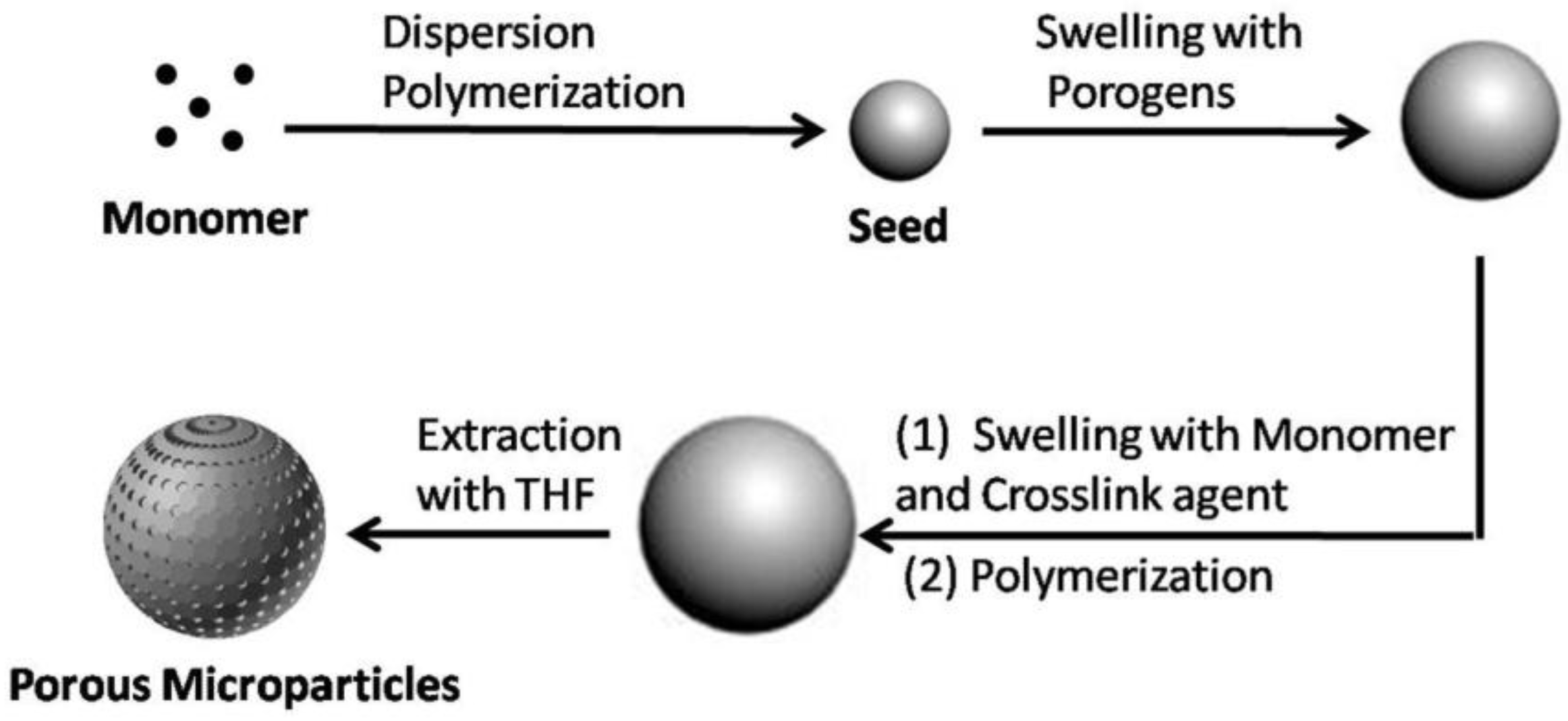
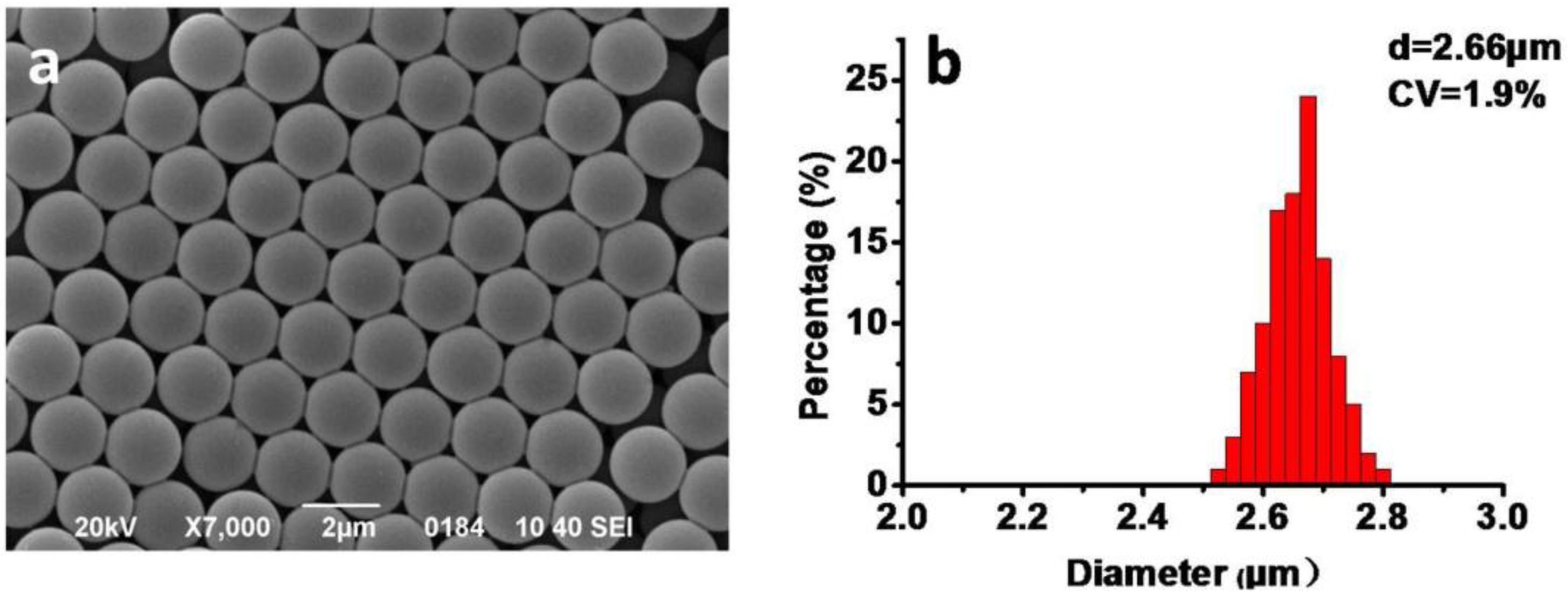

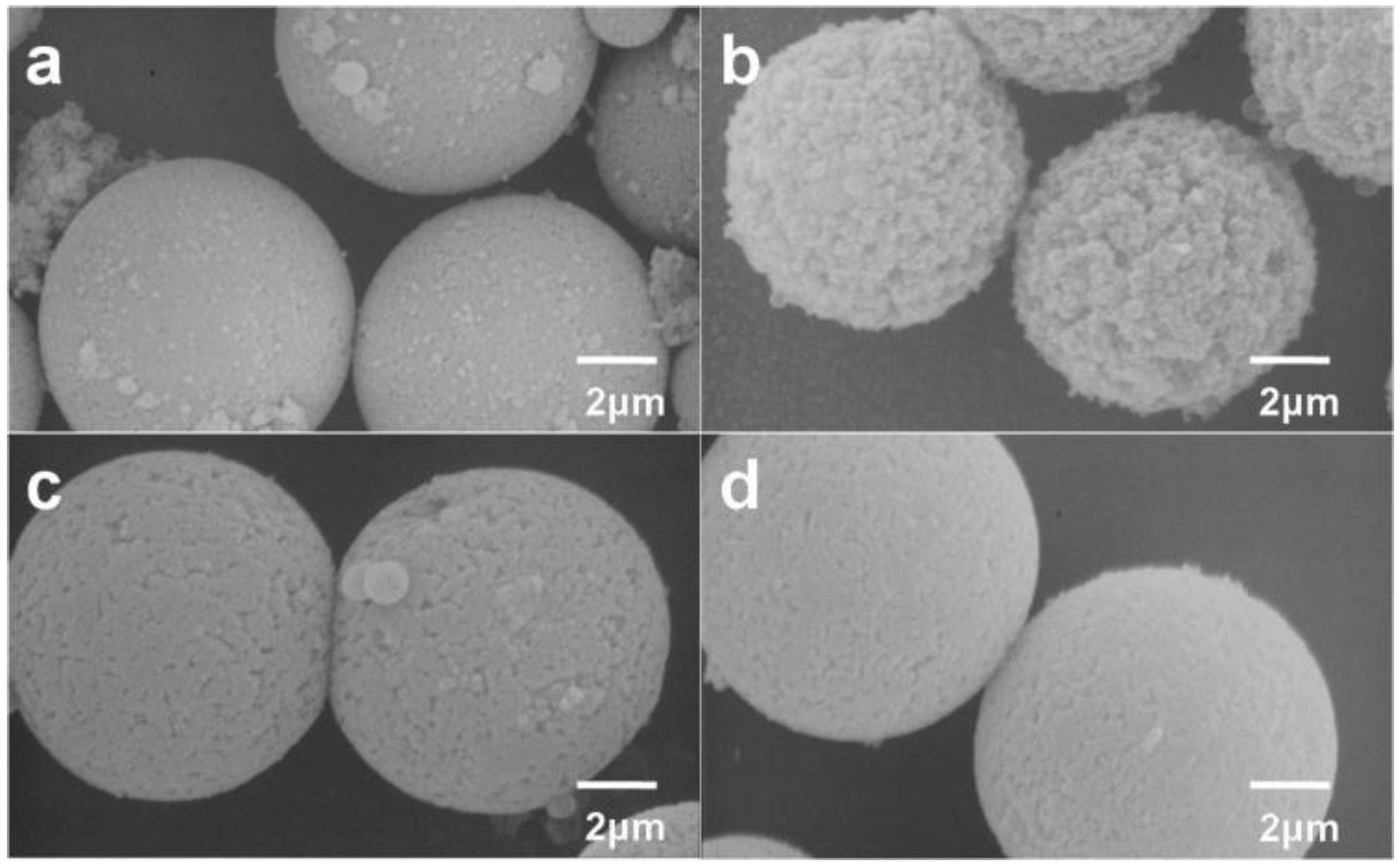
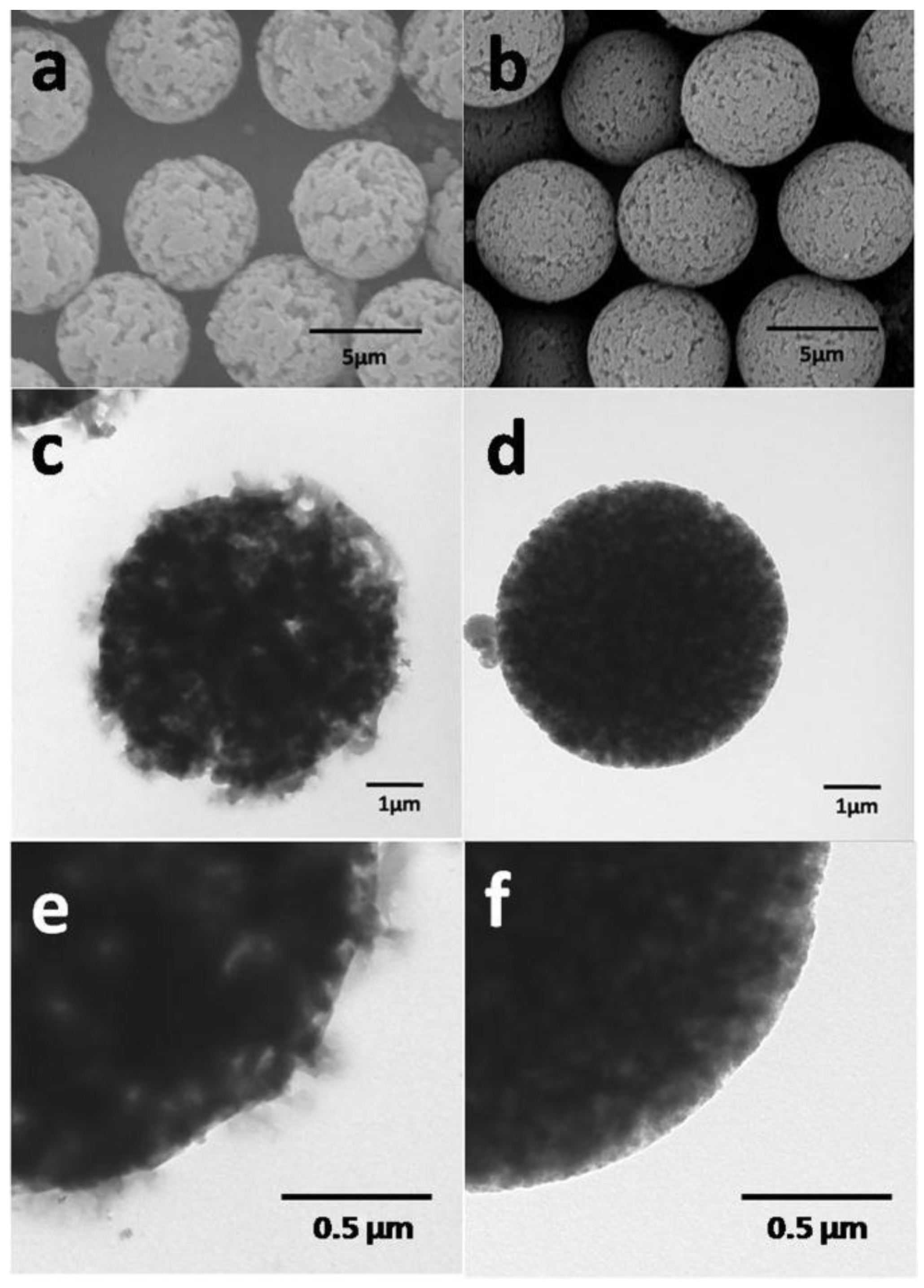
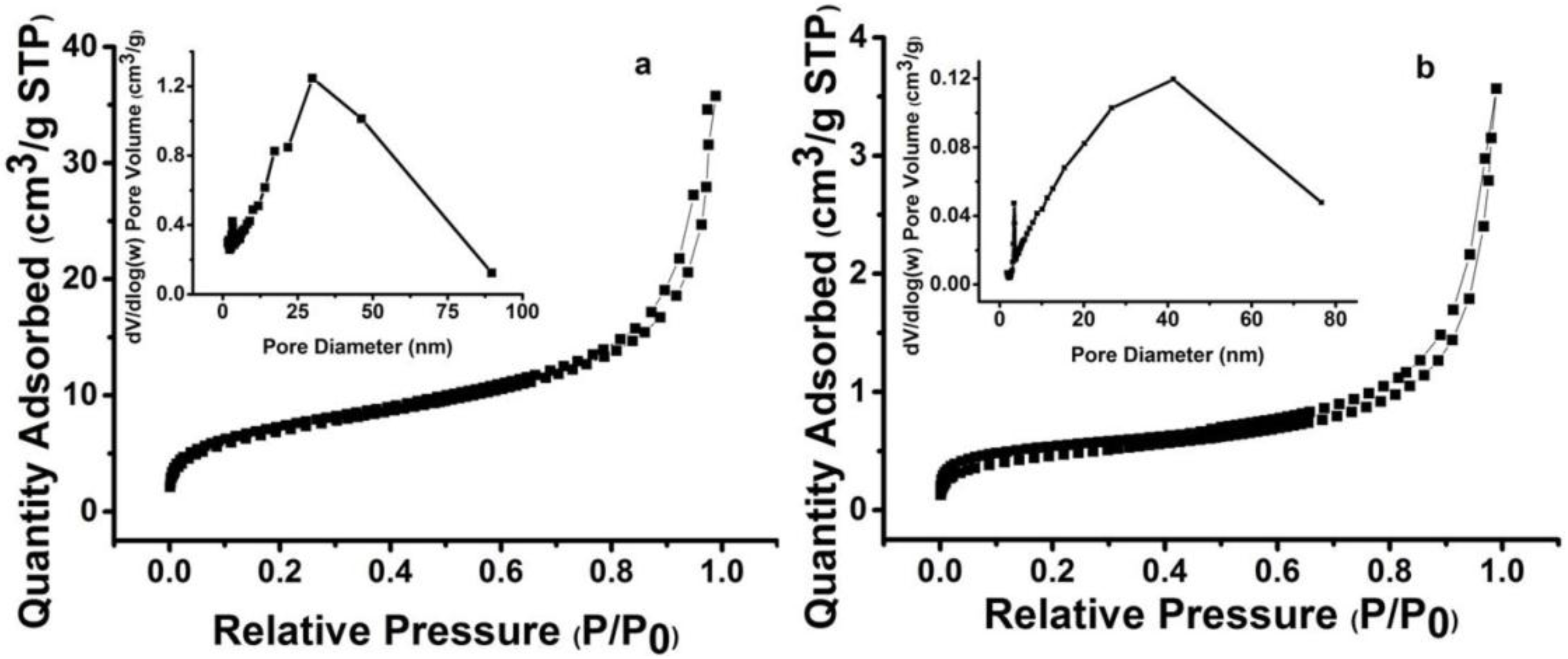
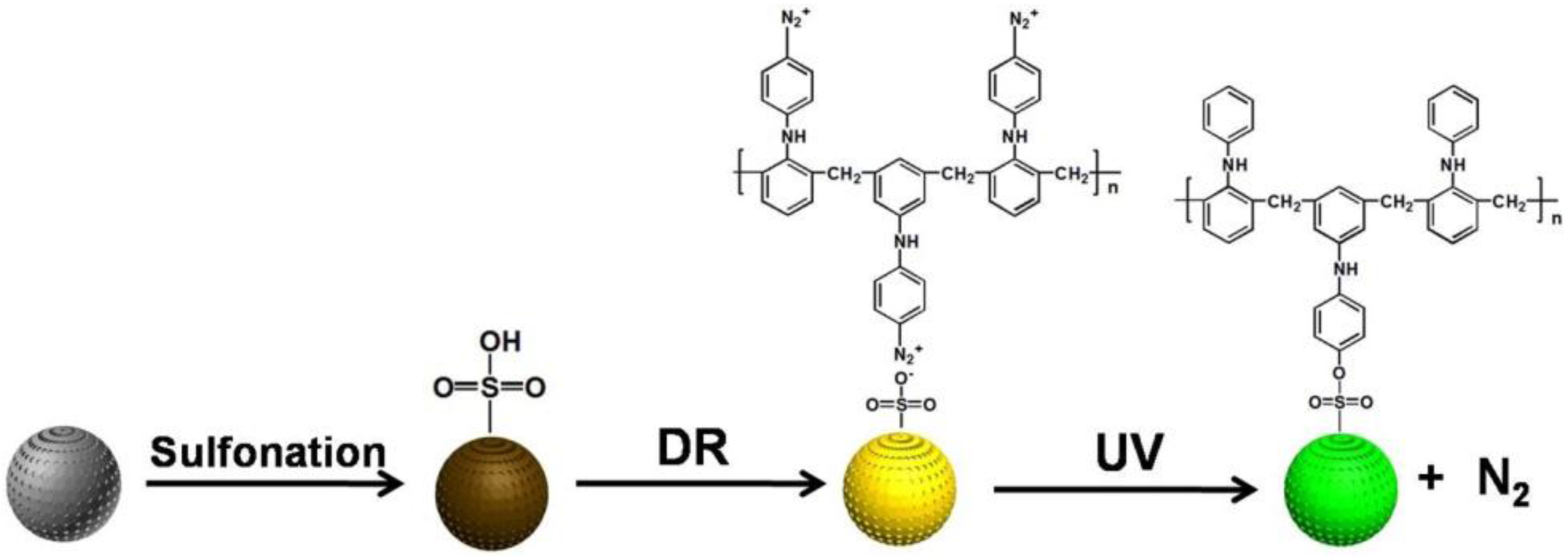
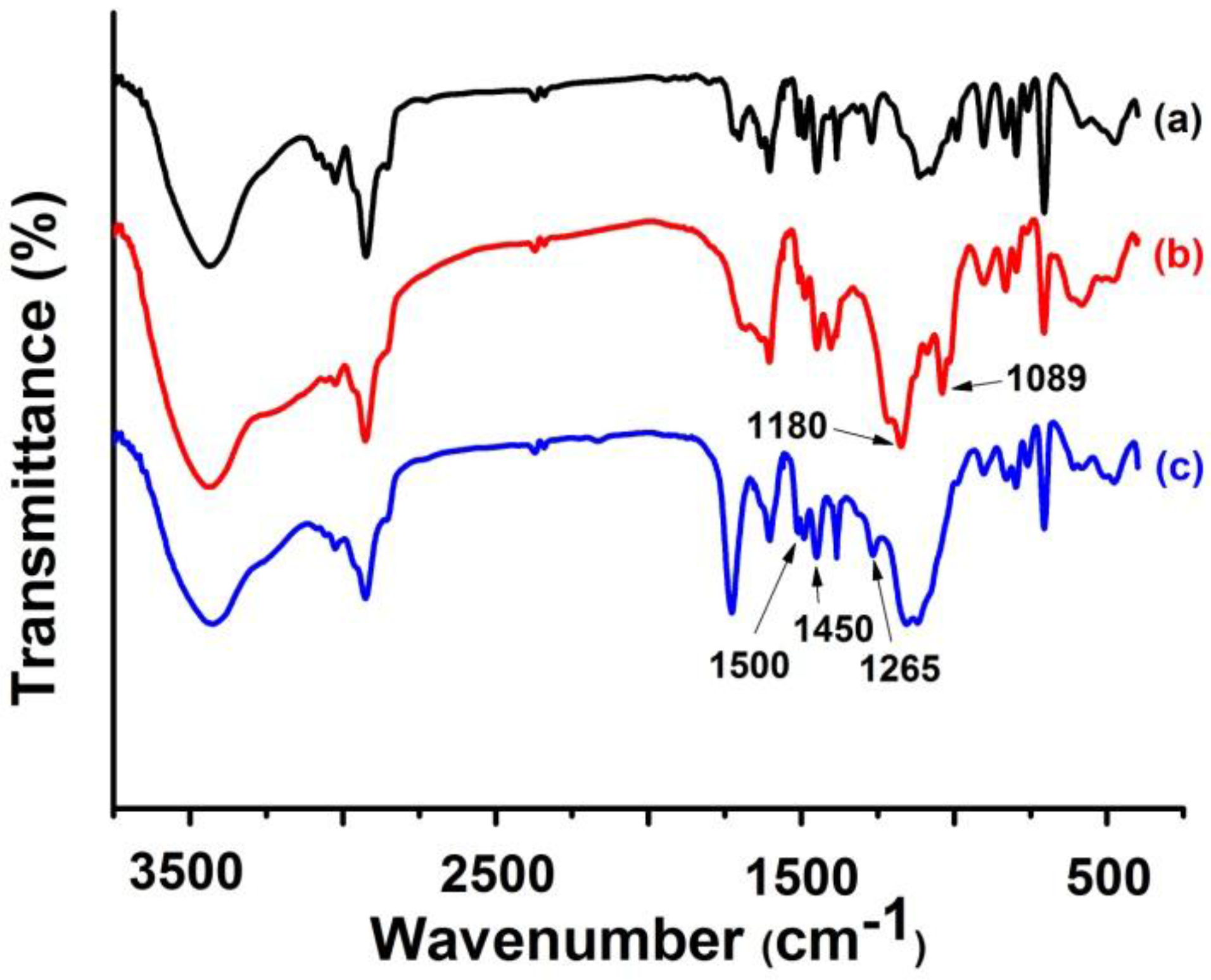
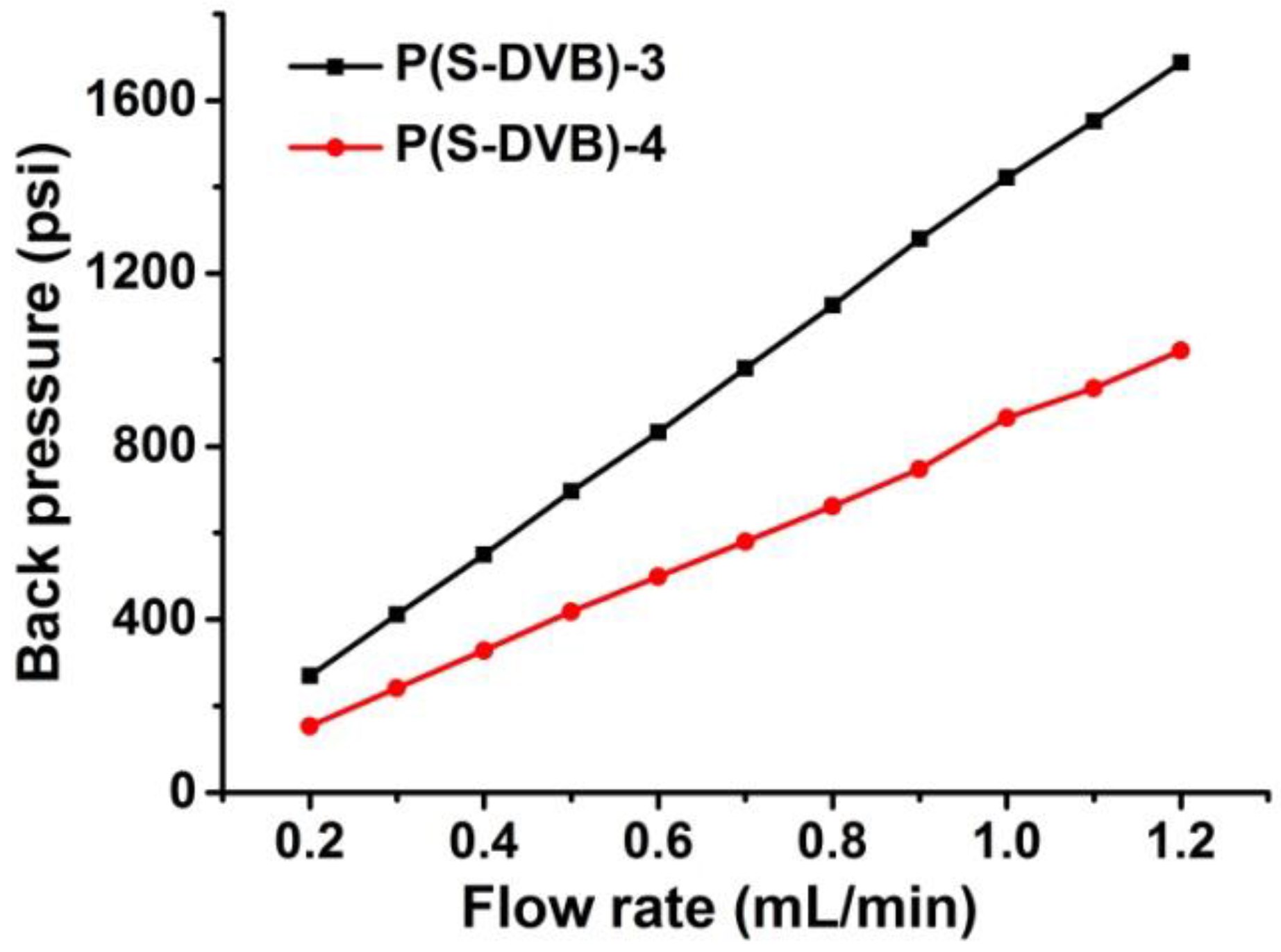
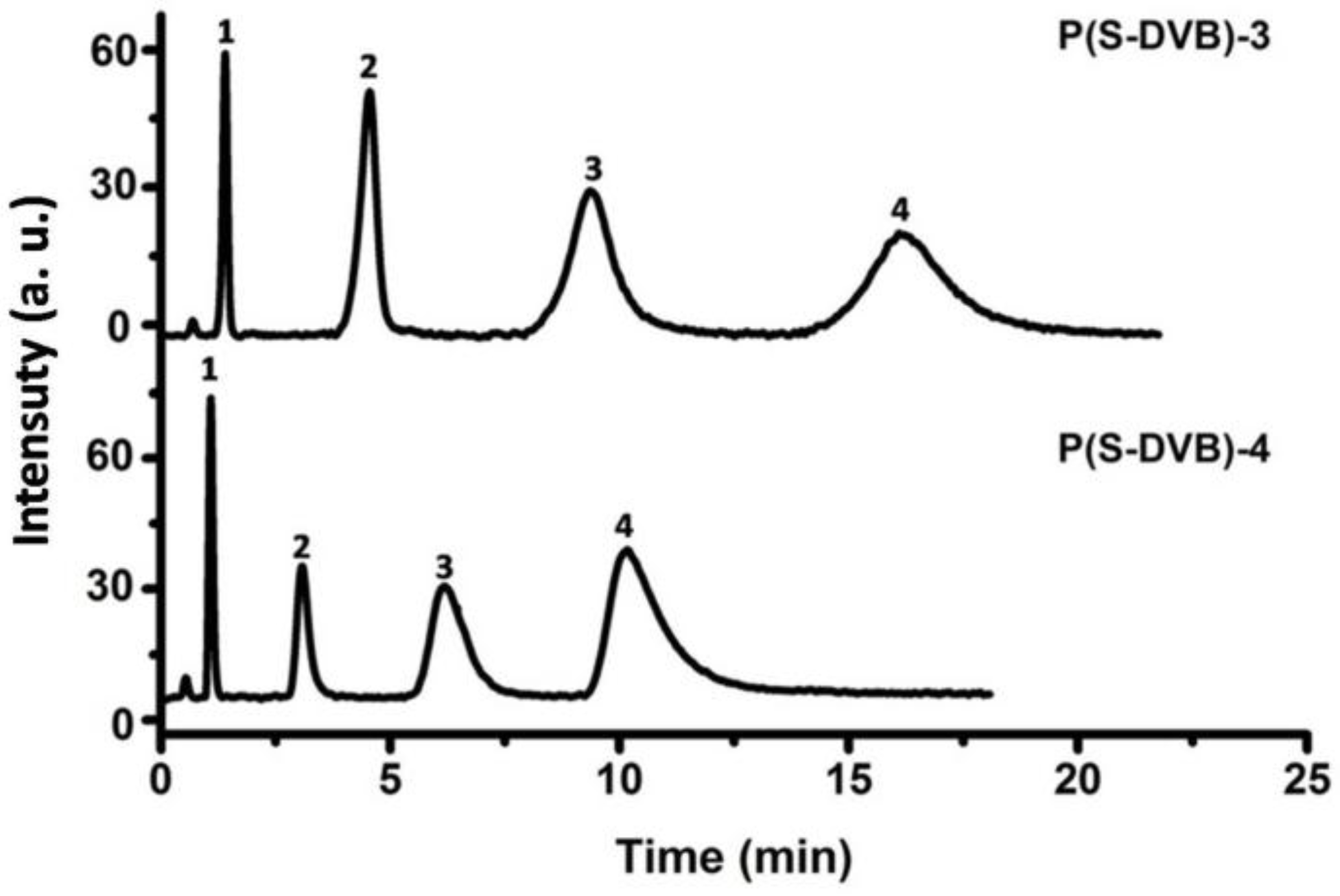

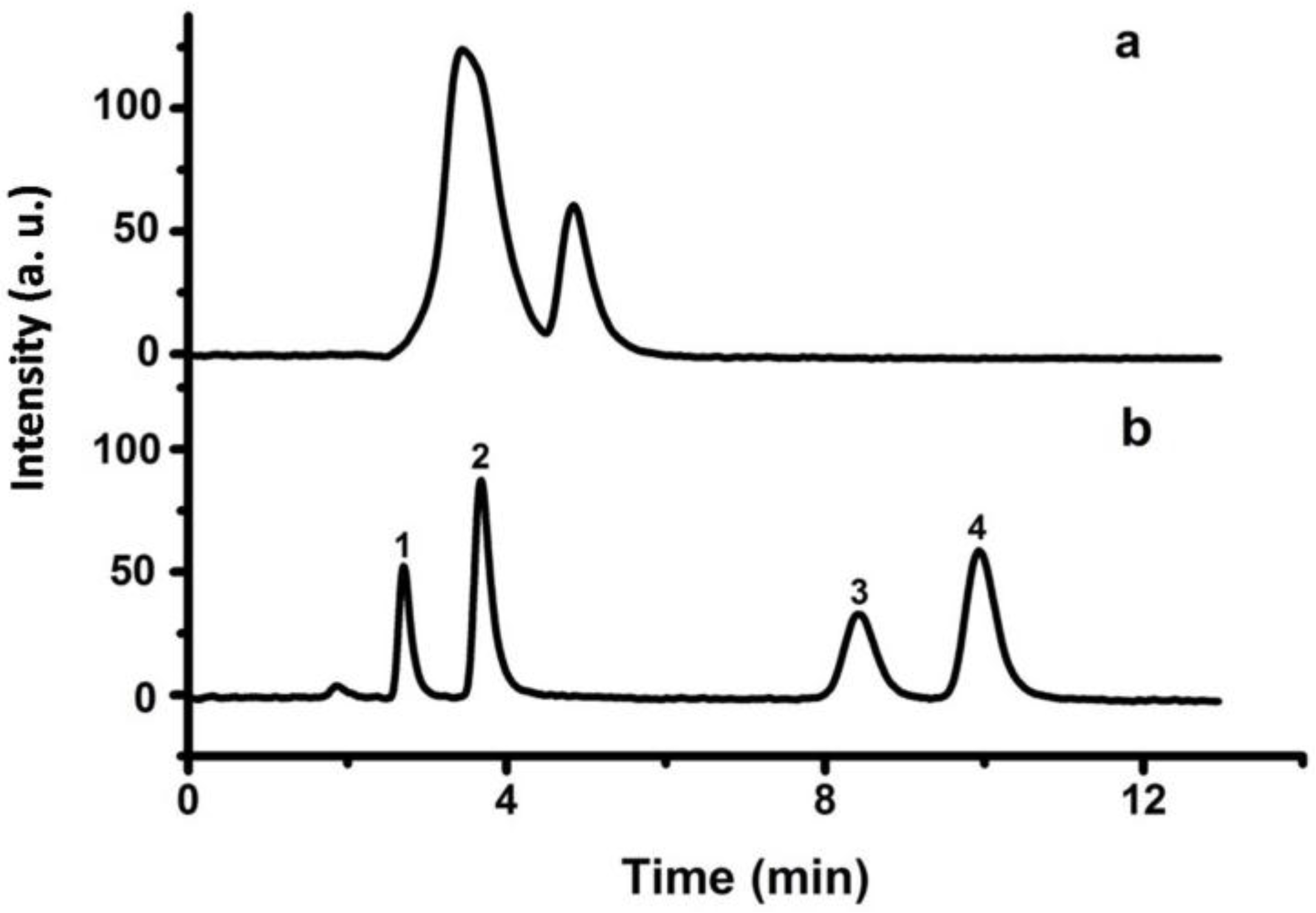
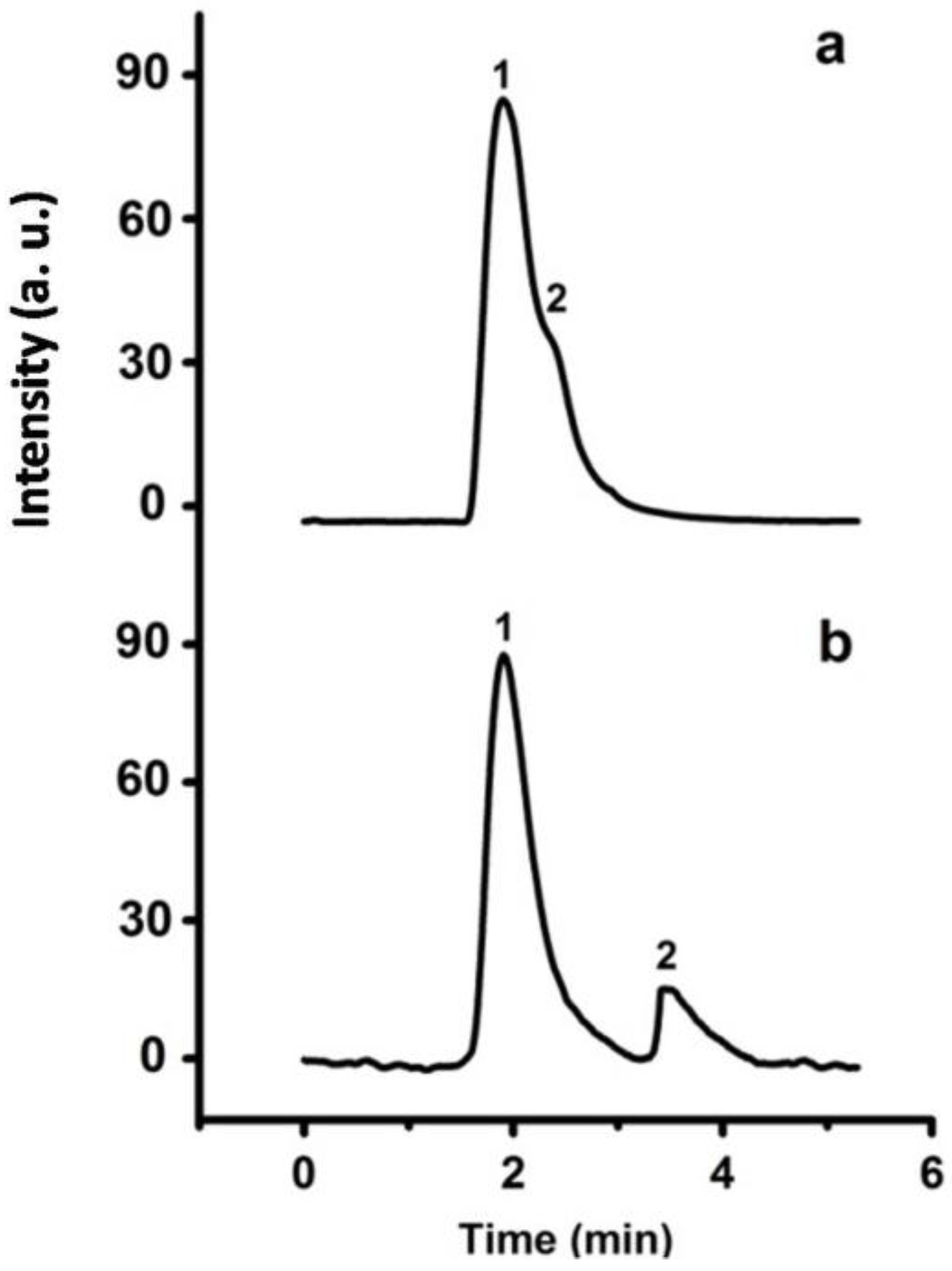
| Sample | Toluene (mL) | DBP (mL) | Swelling Temperature (°C) | DVB (mL) | EDMA (mL) |
|---|---|---|---|---|---|
| P(S-DVB)-1 | 0 | 2.4 | 35 | 2.0 | 0 |
| P(S-DVB)-2 | 0.6 | 1.8 | 35 | 2.0 | 0 |
| P(S-DVB)-3 | 1.2 | 1.2 | 35 | 2.0 | 0 |
| P(S-DVB)-4 | 1.8 | 0.6 | 35 | 2.0 | 0 |
| P(S-DVB)-5 | 2.4 | 0 | 35 | 2.0 | 0 |
| P(S-DVB)-6 | 1.2 | 1.2 | 15 | 2.0 | 0 |
| P(S-DVB)-7 | 1.2 | 1.2 | 25 | 2.0 | 0 |
| P(S-DVB)-8 | 1.2 | 1.2 | 45 | 2.0 | 0 |
| P(S-EDMA) | 1.2 | 1.2 | 35 | 0 | 2.0 |
| Retention Time RSD (%) | ||||
|---|---|---|---|---|
| Benzene Analogues a | Run to Run | Day to Day | Column to Column | Continuous 100 Times Running |
| (n = 5) | (n = 7) | (n = 5) | ||
| Uracil | 0.56 | 1.54 | 2.21 | 1.65 |
| Toluene | 0.79 | 1.65 | 2.89 | 1.86 |
| Naphthalene | 0.81 | 1.87 | 3.32 | 2.16 |
| Fluorene | 0.86 | 2.23 | 3.47 | 2.32 |
| Retention Time RSD (%) | ||||
|---|---|---|---|---|
| Organic Acids a | Run to Run | Day to Day | Column to Column | Continuous 100 Times Running |
| (n = 5) | (n = 7) | (n = 5) | ||
| Formic Acid | 0.81 | 1.84 | 2.46 | 2.12 |
| Acetic Acid | 0.75 | 1.65 | 2.32 | 1.93 |
| Lactic Acid | 0.98 | 1.98 | 3.43 | 2.43 |
| Benzoic Acid | 0.92 | 1.89 | 3.12 | 2.24 |
© 2017 by the authors. Licensee MDPI, Basel, Switzerland. This article is an open access article distributed under the terms and conditions of the Creative Commons Attribution (CC BY) license (http://creativecommons.org/licenses/by/4.0/).
Share and Cite
Yu, B.; Xu, T.; Cong, H.; Peng, Q.; Usman, M. Preparation of Porous Poly(Styrene-Divinylbenzene) Microspheres and Their Modification with Diazoresin for Mix-Mode HPLC Separations. Materials 2017, 10, 440. https://doi.org/10.3390/ma10040440
Yu B, Xu T, Cong H, Peng Q, Usman M. Preparation of Porous Poly(Styrene-Divinylbenzene) Microspheres and Their Modification with Diazoresin for Mix-Mode HPLC Separations. Materials. 2017; 10(4):440. https://doi.org/10.3390/ma10040440
Chicago/Turabian StyleYu, Bing, Tao Xu, Hailin Cong, Qiaohong Peng, and Muhammad Usman. 2017. "Preparation of Porous Poly(Styrene-Divinylbenzene) Microspheres and Their Modification with Diazoresin for Mix-Mode HPLC Separations" Materials 10, no. 4: 440. https://doi.org/10.3390/ma10040440






